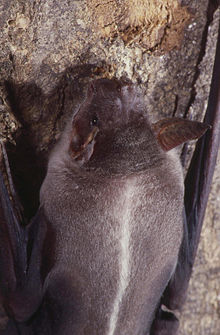| Bulldog bats Temporal range: Miocene to Recent
| |
|---|---|

| |
| Greater bulldog bat (Noctilio leporinus) | |
| Scientific classification | |
| Domain: | Eukaryota |
| Kingdom: | Animalia |
| Phylum: | Chordata |
| Class: | Mammalia |
| Order: | Chiroptera |
| Suborder: | Yangochiroptera |
| Superfamily: | Noctilionoidea |
| Family: | Noctilionidae Gray, 1821 |
| Genus: | Noctilio Linnaeus, 1766 |
| Type species | |
| Noctilio americanus | |
| Species | |
The bat family Noctilionidae, commonly known as bulldog bats or fishing bats, is represented by two extant species, the greater and the lesser bulldog bats,[1] as well as at least one fossil species, Noctilio lacrimaelunaris, from the Miocene of Argentina.[2] The naked bulldog bat (Cheiromeles torquatus) does not belong to this family, but to the family Molossidae, the free-tailed bats. They are found near water in the Neotropics, from Mexico to Argentina and also in the Caribbean islands. In these areas they can be found roosting in groups within hollow trees, caves, manmade homes, or other openings with enough space.[3][4] While the two species exhibit different social and foraging behaviors both tend to return to a main roosting spot while also visiting other alternative roosting spots. [3][4]
- ^ Wilson, D. E.; Reeder, D. M., eds. (2005). Mammal Species of the World: A Taxonomic and Geographic Reference (3rd ed.). Johns Hopkins University Press. ISBN 978-0-8018-8221-0. OCLC 62265494.
- ^ Naish, Darren. "Fossil Bat Stories, Part 3: Bulldog Bats".
- ^ a b Brooke, Anne P. (1997). "Social Organization and Foraging Behaviour of the Fishing Bat, Noctilio leporinus (Chiroptera:Noctilionidae)". Ethology. 103 (5): 421–436. doi:10.1111/j.1439-0310.1997.tb00157.x. ISSN 1439-0310.
- ^ a b Wohlgenant, T.; Pedersen, S.; Adkins, B.; Syme, D. M.; Pearl, D.; Merriman, C. B.; Long, J.; Dunning, D. C.; Audet, D. (1993-08-20). "Activity Patterns and Roost Selection by Noctilio albiventris (Chiroptera: Noctilionidae) in Costa Rica" (PDF). Journal of Mammalogy. 74 (3): 607–613. doi:10.2307/1382280. ISSN 0022-2372. JSTOR 1382280.